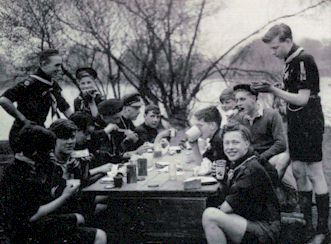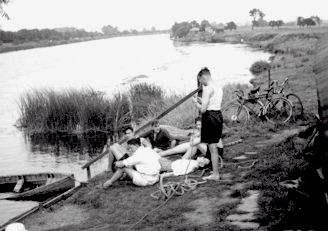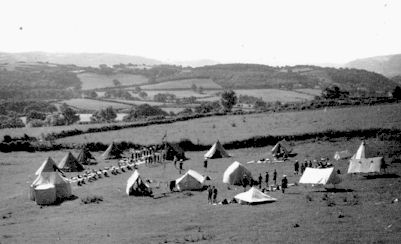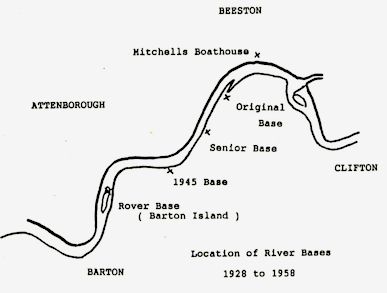



© David Hallam 1988 - 2006
|
Black & Gold - the Story of 2nd Beeston Sea Scouts - continued
All Hands on Deck (July 1945 to December 1949) -
The War was now over, it was a time to pause for celebration and the Group's Parents' Committee organised a Victory Night Dance which really could not
fail to be the social highlight of the year as far as the Group was concerned. However, as we have seen, there was much to be done to get things on
'even keel' again. Luckily, the Group was well placed to respond to the challenge - above all it had the leadership and membership to get the things
done that were needed. Of crucial importance was the formal re-formation of the Rover Crew as members returned from the Forces. Fred Thraves was appointed
RSL and Canon Halet continued the tradition of vigil, preparation and investiture for intending new rovers. Edward Smedley took over as Scoutmaster with
Peter Burton as ASM and Mrs Margaret Smedley (previously Miss Hillery) was in charge of the cubs for a time.
But first, there was summer camp - that year, 1945, it was slightly further afield at Cromford. This time there were 34 in camp; an advance party of five
went by lorry, with the kit, on the Friday, Arthur and Edward Smedley each went by car taking eight others, another eleven cycled and the rest arrived by
train. It was here that something of a camp tradition was established - the adoption of the hit song of the moment as the camp song - that year it was 'Don't
Fence Me In'. It was at this camp, as well, that a practical joke back-fired - one scout trying to give everyone a. scare by putting a. can of treacle
on the fire did not get away fast enough and caught the explosion himself, finishing up at the local hospital but luckily with no lasting ill effects.
New names appearing at the time of this camp were Doug Aldridge, Leslie Daykin, Robert Lofthouse, Russ Neild, William Ostrom, John Brian Stokes, Ian Stone and Wolf.
Once back at Beeston, the River Base was top on the action list. What was left of the buildings from the old site had been moved to the new site but there
was a need to add to them to cater for the numbers who would be using the base and to provide improvements generally. There was also a more fundamental
problem - the site was by no means ideal mainly because the bank was subject to continuous erosion. What was urgently required was a concrete landing
stage, or 'hard' as it was always known, and a slip-way, paths, etc.
 For the next few years, then, there were almost continuous working parties to get things set up. Officers and lads, in particular the rovers and seniors,
would go to the River for the weekend and would give up their holidays to spend the whole time moving gravel or mixing and laying concrete. The picture on the
left includes Ronnie Burton (standing left), Brian Underwood (eating left), Bernard Highton (peaked cap), Harvey Stubbs (with mug), Jimmy Newbury (eating left),
Peter Bertram (drinking), Artie Smith (back right), Harry Banner (eating right), Tony Krarup (standing right) and Percy Warner (foreground right).
For the next few years, then, there were almost continuous working parties to get things set up. Officers and lads, in particular the rovers and seniors,
would go to the River for the weekend and would give up their holidays to spend the whole time moving gravel or mixing and laying concrete. The picture on the
left includes Ronnie Burton (standing left), Brian Underwood (eating left), Bernard Highton (peaked cap), Harvey Stubbs (with mug), Jimmy Newbury (eating left),
Peter Bertram (drinking), Artie Smith (back right), Harry Banner (eating right), Tony Krarup (standing right) and Percy Warner (foreground right).
Getting building materials was by no means easy as they were controlled and required for reconstruction of war damage and housebuilding. Fifteen tons of gravel and cement
were eventually obtained and moved up to the site on a. borrowed barge for mixing on site. The move by barge itself proved difficult - it could not come
right into the bank at the base because of a shallow area close in and, as a result, the whole load had to be moved ashore by bucket chain across a
gang plank. Other building materials, including bricks and corrugated iron, had to be salvaged from what was available. The Anderson shelters being
removed from the area by the Council were one source of the latter and a useful source of bricks and more iron sheets was a large air-raid shelter being
demolished at the rear of the old Jolly Anglers Pub, then on the Canal side.
 A start had been made to replace the boat fleet with the arrival of the first cob boat in early 1945. This was now followed by another similar cob boat
and a 26ft Ship's Lifeboat obtained by Peter Bertram from friends of his mother, in Liverpool. The life boat arrived by train at Nottingham, was put into the Canal basin and brought
through the Canal to Beeston. It was hoped that this boat would prove a worthy replacement for the 'Colona' which had been 'lost' to the 1st Notts. Now
that the Troop also had two cob boats, they were able to be painted with a red and a green stripe respectively and allocated appropriately to the patrols
of the Port and Starboard watch. The photograph on the right appears to show a working party at the river base about this time, about to recover one of the
cobs that has been temporarily submerged by river conditions. Breeze Smedley, standing, appears to be splicing the end of a rope. The sailing dinghies were, for
the moment, without serviceable sails and remained that way for some years with only a few opportunities arising for sailing experience arising for the lads. What little
resources there were available had to be made the most of; Brian Underwood, for instance bought Fred Thraves' old skiff, 'Sevarht' ('Thraves' backwards)
to find after removing all the rotten wood that there was very little left - but it still, eventually, floated again.
A start had been made to replace the boat fleet with the arrival of the first cob boat in early 1945. This was now followed by another similar cob boat
and a 26ft Ship's Lifeboat obtained by Peter Bertram from friends of his mother, in Liverpool. The life boat arrived by train at Nottingham, was put into the Canal basin and brought
through the Canal to Beeston. It was hoped that this boat would prove a worthy replacement for the 'Colona' which had been 'lost' to the 1st Notts. Now
that the Troop also had two cob boats, they were able to be painted with a red and a green stripe respectively and allocated appropriately to the patrols
of the Port and Starboard watch. The photograph on the right appears to show a working party at the river base about this time, about to recover one of the
cobs that has been temporarily submerged by river conditions. Breeze Smedley, standing, appears to be splicing the end of a rope. The sailing dinghies were, for
the moment, without serviceable sails and remained that way for some years with only a few opportunities arising for sailing experience arising for the lads. What little
resources there were available had to be made the most of; Brian Underwood, for instance bought Fred Thraves' old skiff, 'Sevarht' ('Thraves' backwards)
to find after removing all the rotten wood that there was very little left - but it still, eventually, floated again.
At this time the River often flooded the lower lying area of Beeston up to the railway station. This problem had become the more critical now that Beeston
Rylands had been developed for housing and by about 1950 flood prevention measures had been put in place. The years at the end of the 1940s, however, usually
produced floods - one year they came up to Nether Street - and the senior members of the Group were able to use their river skills to assist on these
occasions by rescuing stranded residents and possessions. In the floods of 1947 the Group lost its new lifeboat which came adrift and went over the weir
and was smashed - but when the weir itself was washed away, the resulting temporary lowering of the River allowed work on the bank at the Base to proceed
more easily.
The buildings at the Base also came under attention - the old bunkhouse needed a new roof and painting was required inside and out - but eventually a full
range of bunkhouse, galley, wardroom, boson's store and heads was constructed.
All this took a lot of money and of crucial importance was the large and active Parents' Committee. As it was once pointed out, subscriptions amounted
to only just over 10% of the amount required to finance the Group's activities, the balance largely coming from a steady stream of dances - some jointly
with the Sea Rangers - whist drives and Jumble sales organised by the Committee. The almost annual River Base Open Day was also a money spinner as well as
a popular event. In 1947 Mr C. Johnson became the Chairman of this Committee.
For the Summer Camp in 1946, the Group was able to restart the tradition of camping by the
sea when 36 Officers, rovers and scouts attended a camp in beautiful, wooded country about two miles out of Scarborough within easy reach of the sea. This was
an excellent camp - despite the recent introduction of bread rationing ! Newcomers at that time Included Allcock, Allsop, Green and Colin Thornhill.
Christmas 1946 saw the start of an annual event which lasted each year until about 1954. This was the Nativity Tableau put on by the Sea Rangers under Alice
Hingley. It was presented at Station Road Schools and in Church following Evensong and the older Scouts and the rovers performed backstage duties and erected
the stage in Church during the afternoon before the performance. Names of Rangers taking part in the 1946 production included Jane Whittingham, Beryl Hingley,
Helen Logan, Jean Halliday, Eileen Lee, Marjery Stubbs, Sheila Bywater, Stella Broughton, Jill Searle, Joy Treece, Joyce Birkinshaw, Mabel Tyers, Dorothy
Freeston, Yvonne Bentley, Sheila Kirkland, Christine Alexander and Mary Wright. After Father Martin left Beeston in 1949 to be Vicar of Clarborough and
Hayton, near Retford, the company visited there to repeat their performance for the benefit of that congregation.
At the 1947 AGM, Bernard Highton - as Treasurer, a role he also held for some years - reported that more of the hard earned funds had been 'invested' in long
term assets in the form of more River Base improvements, an outboard engine and a much needed trailer which could be used, above all, to get building
materials to the River.
 Summer Camp in 1947 found the Group back in North Wales at Conway. This was highly successful, at a splendid location with glorious weather, and the biggest yet in the history of the
Group with over 40 members attending. We are reminded, by the surviving accounts of this camp, of the continuing difficult conditions of the day - food
rationing still applied, and was to do so for several years, making camp catering doubly difficult. The ration included such specific foodstuffs as bread,
tea, jam, butter, margarine, cooking fat, sugar, cheese, meat and bacon. Incidentally, this problem also applied to uniforms which still came within the
control of clothes rationing despite pleas for dispensation. Those appearing for the first time include Nelson Bateman, Ted Bestwick, Stanley Chapman,
Estone, Fines, Derek Tipping and R. Walker. (Click the picture on the left to see a photograph of those attending and other scenes.)
Summer Camp in 1947 found the Group back in North Wales at Conway. This was highly successful, at a splendid location with glorious weather, and the biggest yet in the history of the
Group with over 40 members attending. We are reminded, by the surviving accounts of this camp, of the continuing difficult conditions of the day - food
rationing still applied, and was to do so for several years, making camp catering doubly difficult. The ration included such specific foodstuffs as bread,
tea, jam, butter, margarine, cooking fat, sugar, cheese, meat and bacon. Incidentally, this problem also applied to uniforms which still came within the
control of clothes rationing despite pleas for dispensation. Those appearing for the first time include Nelson Bateman, Ted Bestwick, Stanley Chapman,
Estone, Fines, Derek Tipping and R. Walker. (Click the picture on the left to see a photograph of those attending and other scenes.)
That year the Troop, under Edward Smedley, secured First Prize for its exhibit at the Local Activities Exhibition, held in Beeston, despite keen competition
from other local youth organisations.
Admiralty Inspections had been held successfully each year since the Group was recognised in 1942. For this annual event, the Group combined with 1st
Notts Sea Scouts. In 1947, for example the inspection was made by Commander Askin RNR at the 1st Notts Base on Barton Island. He was accompanied by
Col Sir John Jardine, Bart. OBE CD, in his Honorary capacity of County Commissioner for Sea Scouts. The inspecting officer was most open in his praise
for the Groups. In his closing remarks he stated that of the 100 or so Sea Scout Troops throughout the Country, there was only one other with such efficiency
and that they could count themselves as Number 1 in sea scouting.
Year after year in this period the various section officers reported increasing membership numbers. The cubs, starting the post-war period with 30 members,
reached 36 by 1950 whilst providing a steady stream of youngsters for the Junior Scouts, and were forced to form a. new six to accommodate their numbers.
Numbers in the Juniors rose from about 30 in 1945 to about 40 in 1950 and the Troop was forced, at one stage, to close its books to all but those entering
from the cubs. With a healthy Senior Troop and a Rover Crew of about 20 - said to be the strongest in numbers and quality in the County - the Group as a whole
numbered over 100 members by the end of the five year post-war period.
 These numbers put a strain on the groups facilities - the scout, senior and rover sections shared the river base, allowing only a one week in three opportunity
each for river activities - for the senior members, much of that was in building work. Something had to be done and, in 1948, RSL Fred Thraves was able
to announce that they had been successful in obtaining a site on the north-eastern end of Barton Island and were to build a Rover Base there. After
heavy involvement in the bank reinforcements at the Scout Base, they now set to equip their new location. A hut was found in the Newark area. and transported
to the site and other building scrounged from wherever possible - at one stage surplus timber from the Forest Football Club ground was obtained and put to good
use ! That year, the weather was kind and Fred Thraves and his strong Crew were able to make impressive progress. The map on the right shows the position of all
river bases used by the Group over the years.
These numbers put a strain on the groups facilities - the scout, senior and rover sections shared the river base, allowing only a one week in three opportunity
each for river activities - for the senior members, much of that was in building work. Something had to be done and, in 1948, RSL Fred Thraves was able
to announce that they had been successful in obtaining a site on the north-eastern end of Barton Island and were to build a Rover Base there. After
heavy involvement in the bank reinforcements at the Scout Base, they now set to equip their new location. A hut was found in the Newark area. and transported
to the site and other building scrounged from wherever possible - at one stage surplus timber from the Forest Football Club ground was obtained and put to good
use ! That year, the weather was kind and Fred Thraves and his strong Crew were able to make impressive progress. The map on the right shows the position of all
river bases used by the Group over the years.
The Sea Scout Trophy Continued to be competed for annually since its inception in 1944. Group photographs of the members who took part in
1946 and 1947 are here.
In most years the only contestants were 2nd Beeston and 1st Notts but in 1949 the competition area was increased from being limited to Nottinghamshire and four
Groups took part. This increased the interest in the competition but made little difference to the result - 2nd won consistently every year except for one year
early in the competition.
Towards the end of the 1940s the Group turned its attention to the various camping trophies which were 'on offer'. The S.W. Notts camping trophy for Juniors
was the Jardine Trophy and, as we have seen, Sturdee Patrol had won it in its first year, 1943, but since then they had had little success - Nelson
Patrol came 5th in 1946 - and it would be 1951 before they would be successful again. The local trophy for Seniors was the Ernest Inger Trophy; in 1947, 2nd
were just beaten, by one point, to first place by 1st Stapleford but were able to report success in the following year and were second in 1949. At County
level, each section competed for a County Flag. The Seniors just failed in 1948 by a small margin but came through to win it in the following year with a
patrol led by J. Bywater. The Junior Section had to wait until 1953 before success for them in their County Flag.
 In 1948 the Group were back at Conway for the Summer Camp. Once again, this was a most successful camp with well nearly 50 members attending. This was
the year in which the Olympic Games were held in Britain. The yachting took place in Tor Bay and four Seniors and a Rover went to assist there. On arrival they
took part in the Opening Ceremony - Brian Underwood carried a banner for Greece and Don Hallam was to carry the Czechoslovakian flag but, at the last moment,
that team did not attend due to the political situation in Eastern Europe.(The picture shows the opening march past with Peter Bertrum amongst those flanking
the saluting base) Following this ceremony thay found that they expected to be in charge of cooking - which is not what they had in mind - but eventually they
became part of the rescue squads and also ferried competing crews to their yachts.
In 1948 the Group were back at Conway for the Summer Camp. Once again, this was a most successful camp with well nearly 50 members attending. This was
the year in which the Olympic Games were held in Britain. The yachting took place in Tor Bay and four Seniors and a Rover went to assist there. On arrival they
took part in the Opening Ceremony - Brian Underwood carried a banner for Greece and Don Hallam was to carry the Czechoslovakian flag but, at the last moment,
that team did not attend due to the political situation in Eastern Europe.(The picture shows the opening march past with Peter Bertrum amongst those flanking
the saluting base) Following this ceremony thay found that they expected to be in charge of cooking - which is not what they had in mind - but eventually they
became part of the rescue squads and also ferried competing crews to their yachts.
Amongst the new names in 1948 were Ian Astle, Bloor, Francis Bright, Maurice Buckby, J. Cook, R. Hewitt, Hughes, Manns, Presland, Keith Sargent, James Shipperbotham,
Stamper, John Starkey and Geof Stephens.
1949 was a year of change. Two of the Group's Officers, both of which had been with the Group as Scouts, went on to District positions; Disney Keeble who had
been Cubmaster for two years, became ADC for Cubs - and eventually District Commissioner - whilst the Rover Leader for the last three years, Fred Thraves,
became ADC for Scouts. The Cubmaster position was taken by Harry Bailey with Harry Beastall assisting ,whilst Peter Burton took over the Rover Scouts.
At the same time, Don Hallam, newly demobbed from National Service in the Navy, took over as Scoutmaster of the Junior Section with Brian Underwood as
ASM whilst Edward Smedley moved to lead the Senior Section. This left the way clear for an announcement, made later in the year at the Group's 21st Birthday
Dinner, of the resignation of Arthur Smedley as GSM and the appointment of his successor, Bernard Highton.
The Annual Camp that year was at Scarborough when 36 members attended. Names appearing at this time include Brian Guy, Rex Beastall, Brian Coxon, Gordon and
Brian Matthews, Bill Norman, R.Parker, Parnell, Michael Rose, David Thornhill, Wilmore, B.Wood, D.Wood and J. Wright.
In October the 21st Birthday Celebration Dinner was held at the Civic Restaurant, Station Road, Beeston (now a Hairdressers and a Restaurant) with about 120 attending.
The Guest of Honour was Revd. A.H. Otway, the founding GSM. Also attending was the Chairman of the Council, Mr T.L.V. White and Field Commissioner Sanderson.
In an introductory speech, in which he also announced his retirement as GSM and the name of his successor - Bernard Highton, Arthur Smedley outlined
the history of the Group recalling the early camps, the War service by the Group and its members and those who had contributed so greatly to its success.
He believed that it was because the tradition of the Group was built on its relationship to the Church , that it had been such a success. In the principal
speech, Rev A. H. Otway, in an understandably reminiscent mood, also spoke of the early days. When the Group was formed, he had decided to concentrate
on quality rather than quantity as he felt one would follow the other. This had proved correct and it was a policy that had paid dividends. Recalling
the first camp, he commented that, at 63, he was still taking boys on this type of annual holiday. Referring to the religious basis of 2nd Beeston, he
said that it was not much use having a Group that was not trying to fulfill its obligations made on Oath - 'I promise, on my honour, to do my best, to
do my duty to God....'. Revd. Otway received an Illuminated Address to commemorate the event and Father Martin, who was leaving the Parish, received
a scout replica. Six members of the Group Committee received Thanks Badges. Arthur Smedley received the Medal of Merit for his exceptional contribution
to the Group, the highest award a District Commissioner may recommend. For a while, he went on to serve as Assistant County Commissioner for Sea Scouts.
The 1940s were drawing to a. close and the Group found itself with a completely new leadership but with strength in quality and numbers and a past
leadership to which it owed much. It was said at that time - with much justification - that it was the best equipped Group in the County but its
'equipment' went far beyond its material possessions - it had a tradition on which it could draw and which would sustain it for the future.
Click to read the next chapter
or -
Click here to go back to the beginning
|
 |